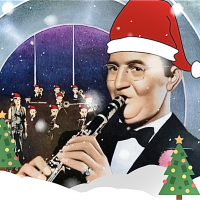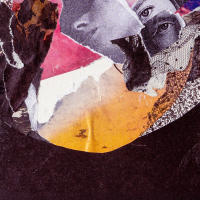The New Orleans Rhythm Kings were one of the hottest jazz bands of the early 1920s, and a strong influence on many later musicians, including Bix Beiderbecke, Muggsy Spanier, Mezz Mezzrow, and Benny Goodman. Best known for their 1923 integrated recording session with Jelly Roll Morton, the NORK’s smooth, swinging style signaled a departure from the raucous novelty sound of the Original Dixieland Jazz Band and its imitators. Another hallmark of the band was its emphasis on solo performances, while traditional New Orleans jazz was still heavily dependent on ensemble playing. The solos of Leon Roppolo on clarinet and George Brunies on trombone are still considered classic, and have often been copied on other bands’ recordings.
Following the success of the Original Dixieland Jazz Band and Tom Brown’s Band in New York and Chicago, savvy club owners were eager to get their own New Orleans bands. Mike Fritzel, owner of the Friars Inn at 343 N. Wabash in Chicago, was quick to capitalize on the new sound. In the fall of 1921, he contacted a New Orleans cornetist named Paul Mares, who was living at the home of a friend (Chicago police officer Tommy Harrison), and asked him to put together a band to play at his club. Mares phoned New Orleans and got childhood friend and trombonist George Brunies, who agreed to come to Chicago for the price of his train fare (paid by Mares’ father) and the loan of an overcoat from Mares’ brother.
Mares also offered a job to another friend, Leon Roppolo, who had been playing clarinet in the band of vaudeville singer Bee Palmer, known as the “Shimmie Queen.” Roppolo had left Palmer’s band in the spring of 1921 to play with Carlisle Evans’ band, followed by a summer stint on the riverboat “S.S. Capitol” on the upper Mississippi with legendary cornetist Emmett Hardy and banjoist Lou Black. Mares, Brunies, and Roppolo were the core�"and the stars�"of the band that would gain fame as the New Orleans Rhythm Kings, although the band would go through several changes of personnel.
The backgrounds of these three men reflected the multi-ethnic composition of New Orleans at the turn of the century. Paul Mares came from a French family who owned a fur business. Roppolo’s parents were Sicilian immigrants; his father ran a grocery store. George Brunies’ family was of German and Belgian stock; the entire family was musical, and brothers Henry, Merritt, Richard, and Albert (Abbie) were all successful musicians and composers. Friars’ Inn was a basement cabaret at 343 Wabash, frequented by gangsters like Dion “The Florist” O’Banion. Originally, the rhythm section would play for the dinner crowd, then the rest of the band would show up around 10 PM for dancing. Band members remember that they would play all night until the last customer left; the “big money boys” who frequented the club would often throw hundred-dollar bills to keep them playing. Roppolo’s volatile nature was evident throughout the band’s engagement at Friars’ Inn; one witness reports that during performances, Roppolo would sometimes throw his clarinet against the wall in a fit of temper, then pick it up again when he had cooled off.
Read more
On April 28, 1922, the band went to the Gennett studio in Richmond, Indiana to wax Livery Stable Blues under the name “New Orleans Rhythm Kings.” The record was never released, and when they made their next recordings for Gennett on August 24, 1922, they went under the name “Friars Society Orchestra, direction Husk O’Hara [sic].” Husk O’Hare was a slick Chicago promoter who managed to get his name on the record label, even though he was neither the director nor manager of the band. He also promoted another group, “Husk O’Hare’s Super Orchestra of Chicago,” whose rendition of San was on the flip side of the Friars Society Orchestra’s first recorded side, Eccentric. Before the Friars Society Orchestra made their third set of recordings, on March 12 and 13, 1923, they had changed their name back to the New Orleans Rhythm Kings, a name originally given to Roppolo’s former band under Bee Palmer.
The original members of the band were Mares, Roppolo, and Brunies, along with another New Orleans musician, Arnold “Deacon” Loyocano on bass. Other band members included saxophonist Jack Pettis, pianist Elmer Schoebel from Illinois, Lou Black on banjo, and Frank Snyder on drums. Schoebel was nominally the leader of the group, as he was the only one in the group at that time who could read music. Loyocano didn’t last long with the band; the hours were too long for him, and he was soon replaced by New Orleans bassist Steve Brown, who later joined Jean Goldkette’s orchestra. Brown was noted for his “slap bass” technique, heard at its best on the Goldkette recording of “Dinah.”
One of the four tunes recorded on the first day of the August session was Farewell Blues, credited to Mares, Roppolo, and Schoebel. The band was experimenting with harmonies and came up with something reminiscent of a train whistle. Brunies remembers that the tune evolved something like this: “… we were playing the ‘Weary Blues’ one night, so all of a sudden Rapp takes a chorus, just playing to himself, man. He didn’t care nothing about the people, he’s high. … So they made a number out of it, the Farewell Blues.” Included in this session was Eccentric, a ragtime piece by ODJB pianist J. Russel Robinson, along with Bugle Call Blues and Discontented Blues. Six days later, the band recorded four more tunes, including Panama, noteworthy for Roppolo’s low-register clarinet solo. They also recorded two sides made popular by the Original Dixieland Jazz Band: Tiger Rag and Livery Stable Blues. A fourth tune, Oriental (co-written by Schoebel), was less memorable.
Shortly after these sides were released, problems arose between the Friars Inn management and the musicians. Schoebel, Brown, and Snyder left the group to play at the Midway Gardens, making records for Gennett under the names Original Memphis Melody Boys and Midway Garden Orchestra. Ben Pollack replaced Snyder on drums, and Mel Stitzel took Schoebel’s place on piano. Jack Pettis left and was replaced by Volly DeFaut. In the fall of 1922, Roppolo was sent back to New Orleans to find a few more musicians to augment the band. He came back with bassist “Chink” Martin Abraham, reedman Nunzio Scaglione, violinist Oscar Marcour, and cornetist Emmett Hardy. The New Orleans men didn’t stay long with the band, partly due to some trouble they had getting union membership. Scaglione was the only one who could read music; the others had to fake their way through the union examination. After about six weeks, Hardy, Marcour, and Scaglione went back to New Orleans. Hardy was ill with tuberculosis, and went home to convalesce; he died of tubercular peritonitis on June 16, 1925, just a few days after his 22nd birthday.
A smaller version of the Friars Inn band recorded for Gennett under the name “New Orleans Rhythm Kings” on March 12 and 13, 1923. The front line of Mares, Roppolo, and Brunies remained intact, with Pollack and Stitzel making up the rhythm section. One of their most famous tunes, Tin Roof Blues, came out of this session. Both Roppolo’s clarinet solo and Brunies’ trombone solo are considered classics; Brunies’ was often copied verbatim on later bands’ recordings.
Shortly after this session, the Rhythm Kings broke up, lost without the musical discipline imposed by Schoebel. As the only “reader” remaining in the group, Schoebel not only taught each man his part, but also arranged the harmonies. Mares and Roppolo headed to New York to perform with Al Siegel’s band in Greenwich Village. Brunies and Pollack remained in Chicago, playing with various bands.
After just a short stay in New York, Mares returned to Chicago, followed a few weeks later by Roppolo. In July 1923, they went to Richmond for the last time, to record with a much larger band, assembled specifically for that purpose. Jack Pettis returned on C-melody sax, Glen Scoville and Don Murray joined on reeds, and Kyle Pierce on piano. Chink Martin played bass, and Bob Gillette (later, with the Wolverines), banjo. Bix Beiderbecke was also present, but did not play on the recordings. This session featured Jelly Roll Morton, also from New Orleans, and is said to be one of the first interracial recording sessions in history. One version says that Morton went to Melrose Music to discuss publication of some of his tunes, and Walter Melrose suggested that he talk to Paul Mares about recording them. Two of Morton’s own compositions were recorded during the July 17 and 18 sessions: Mr. Jelly Lord and London Blues. Morton also wrote the introduction and verse to Milenberg Joys, which was jointly credited to Morton, Mares, and Roppolo, with lyrics by Walter Melrose.
Afterward, Mares went back to New Orleans. Roppolo played with several other bands, including Peck’s Bad Boys in Texas and Carlisle Evans’ band in Minneapolis. Brunies took a job with Ted Lewis’ band. In the fall of 1924, Roppolo became ill and had to return to New Orleans. At the end of January 1925, Santo Pecora put together a band to record for Okeh, the company’s first field recordings in that city. He got Roppolo and Mares, and several of his fellow musicians from Abbie Brunies’ Halfway House Orchestra: Leo Adde on drums, Bill Eastwood on banjo, Chink Martin on bass, Lea (Red) Long on piano, and Charlie Cordilla on tenor sax. This group recorded under the name “Original New Orleans Rhythm Kings,” but Mares and Roppolo were the only ones from the original band.
Just two months after this session, Victor decided to record the same compositions with the same musicians. During a rehearsal at Mares’ house, Roppolo stormed out in anger and was replaced by Charlie Cordilla on the recordings. The cause of this incident was, depending on the narrator, either that Roppolo picked a fight with Pecora, or that the recording engineer told him to stop playing those “pea-whistle notes” in the altissimo register. Not long after this session, Roppolo was committed to an insane asylum; his heavy marijuana use and violent outbursts are usually cited as the reason. He played saxophone in the hospital’s band, and was released briefly around 1940; he sat in with Santo Pecora’s band on the S.S. Capitol for a few nights. Roppolo died in 1943.
George Brunies was with Ted Lewis’s band for a number of years, then moved to New York in 1935, where he played with Muggsy Spanier and Eddie Condon. Brunies moved back to Chicago in 1949, where he formed his own band. On the advice of a numerologist, he changed the spelling of his name to Georg Brunis. He died in Chicago in 1974.
Paul Mares worked in the family fur business for a time, but missed the musician’s life. He revived the band’s name again on some recordings in the 1930s, but he was the only one of the original Rhythm Kings in the group. He opened the P&M barbecue restaurant in Chicago, which served as a hangout for jazz musicians. During World War II, Mares took a job in a defense plant. He died in 1949.
Bio by Suzanne Fischer. Source: Suzanne Fischer
Show less
























